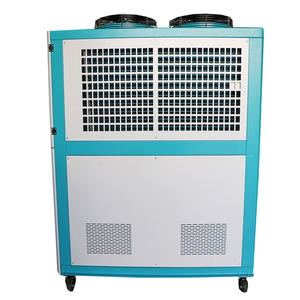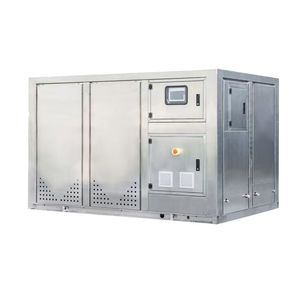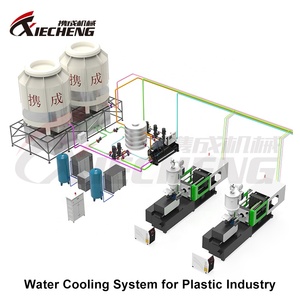(10992 products available)












































































































































































































A scroll chiller is a refrigeration machine that uses a scroll compressor to chill water. Generally, it is divided into two main categories: air-cooled and water-cooled chillers. Air-cooled scroll chillers use ambient air to dissipate heat through a condenser. Conversely, water-cooled scroll chillers use water for heat rejection. Both types can be further classified into indoor and outdoor installations.
Another common way to categorize scroll chillers is by their operating principle, constant load, or variable load. A constant load scroll chiller maintains a constant temperature. On the flip side, a variable load scroll chiller can adapt to changes in process cooling loads. It thereby offers a more energy-efficient cooling solution.
Air-cooled scroll chiller:
An air-cooled scroll chiller dissipates heat from its condenser to the surrounding ambient air. It comprises a condenser coil, an evaporator coil, a compressor, a fan, and other key components. As noted before, an air-cooled condenser can be indoors or outdoors. The indoor air-cooled scroll chiller is suitable for installation in smaller spaces or where outdoor installations may not be feasible. Alternatively, outdoor models are designed to be installed outside the building.
Water-cooled scroll chiller:
A water-cooled scroll chiller is designed to reject heat to water. It can be connected to a cooling tower, heat exchanger, or any other water source. Water-cooled scroll chillers are often used in industrial and commercial settings that require efficient cooling solutions. An easy way to identify a water-cooled scroll chiller is through its heat exchanger. While some use evaporator cooling coils, others have shell-and-tube or water-to-water heat exchangers.
China scroll chillers typically have the following specifications:
Generally, scroll chillers have become significant components in diverse industries, especially in cooling applications. They are commonly used in industrial manufacturing processes to control temperatures. They are also used in food and beverage facilities to chill products and even ensure the proper functioning of equipment. Moreover, scroll chillers are used in commercial buildings such as hospitals, offices, shopping malls, and large residential complexes where central air conditioning systems are required to enhance indoor air quality and comfort.
In the pharmaceutical and chemical industries, maintaining precise temperature control is crucial for the stability of products and chemical reactions. Scroll chillers are widely used in these industries to cool reaction vessels, fermentation tanks, and other equipment. Furthermore, scroll chillers are used in data centers and server rooms to dissipate heat from racks and maintain optimal operating temperatures for servers and networking equipment. Additionally, the refrigerators and freezers in cold storage facilities need to be consistently chilled to preserve products and scroll chillers can be used to achieve this goal.
Generally, the versatility and efficiency of scroll chillers make them an ideal choice for any industry requiring consistent cooling.
A variety of factors must be considered when selecting the appropriate industrial scroll chiller for a facility or application.
Cooling Capacity
The amount of heat a scroll chiller is capable of removing from an area is referred to as its cooling capacity. Businesses will need to calculate the amount of heat (in kilowatts or BTUs) generated by the process or space to be cooled. Furthermore, they must account for external factors such as the temperature of the ambient air, insulation, and any other equipment that generates heat. A properly sized scroll chiller will be efficient and effective, so it is critical to avoid undersizing and oversizing the unit.
Energy Efficiency
When selecting a scroll chiller, it is critical to prioritize energy efficiency. The chiller's energy usage will cost the company significant money over time. As a result, selecting a chiller with a high energy efficiency rating will help to reduce operating costs and environmental impact. Familiarize oneself with the different energy efficiency ratings, such as EER (Energy Efficiency Ratio) and SEER (Seasonal Energy Efficiency Ratio), and choose a scroll chiller with a high EER or SEER rating to ensure excellent energy performance.
Operating Conditions
When choosing a scroll chiller, pay attention to the operating conditions. To ensure proper compatibility and performance, it is critical to evaluate the specific operating conditions of the application. Need to consider factors such as the ambient temperature of the area where the scroll chiller will be installed, the cooling medium to be used (usually water), and any other specific requirements of the application environment. Choosing a scroll chiller that is specifically designed to meet the operating conditions will ensure maximum efficiency and reliability.
Type of Refrigerant
The scroll chiller's refrigerant plays a critical role in its cooling efficiency and environmental impact. While the most common refrigerant is R-410A, other options such as R-407C or R-1234ze may also be considered based on specific application requirements. Select a scroll chiller with a refrigerant that provides optimal cooling performance for the given application. In addition, choose a refrigerant that has a low global warming potential (GWP) to lessen the environmental impact.
Q1: What are the Scroll chillers' critical components?
A1: The primary Scroll chiller components are the compressor, condenser, evaporator, expansion device, and refrigerant.
Q2: What categories of Scroll chillers are available?
A2: The main categories of Scroll chillers are air-cooled Scroll chillers and water-cooled Scroll chillers. Air-cooled Scroll chillers use ambient air for the condenser to reject heat. Water-cooled Scroll chillers use water as a medium to reject heat from the condenser.
Q3: What benefits does a Scroll chiller provide?
A3: The Scroll chiller offers several benefits. It has a compact design that occupies less space. It runs quietly and produces less noise. Its user-friendly interface allows easy operation and control. It requires less maintenance and allows rapid system diagnostics, and the robust construction makes the device durable.